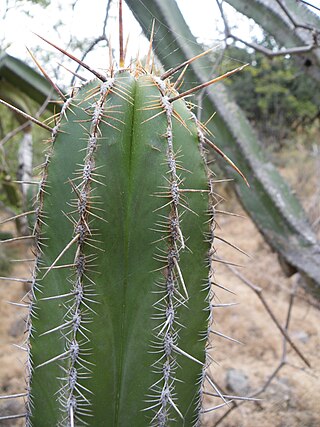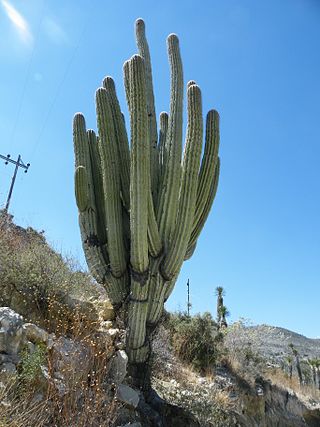
Cephalocereus is a genus of slow-growing, columnar-shaped, blue-green cacti. The genus is native to Mexico.

Escontria is a genus of cactus. The only species is Escontria chiotilla, the chiotilla or jiotilla.

Arthrocereus melanurus is a species of plant in the family Cactaceae. It is endemic to Brazil. Its natural habitats are dry savanna and rocky areas. It is threatened largely by habitat loss.

Cleistocactus hyalacanthus is a species of columnar cacti in the genus Cleistocactus. The name comes from the Greek kleistos meaning closed because the flowers hardly open.

Mammillaria gigantea is a species of cactus in the subfamily Cactoideae native to Mexico. It is named for its large size.

Mammillaria carnea is a species of cactus in the subfamily Cactoideae.

Soehrensia thelegona is a species of cactus in the Soehrensia genus.

Stenocereus stellatus is a flowering plant in the family Cactaceae that is found in Oaxaca, Mexico

Praecereus euchlorus is a flowering plant in the family Cactaceae that is found in Brazil, Bolivia and Paraguay at elevations of 700 to 1300 meters

Acanthocalycium spiniflorum is a species of flowering plant in the cactus family Cactaceae from Argentina.

Soehrensia formosa, is a species of Echinopsis found in South America. In north-western Argentina, Bolivia and northern Chile. First published in Cactac.: Handb. Kakteenk. 3: 1678 in 1959.

Xiquexique gounellei is a species of plant in the genus Xiquexique of the cactus family. Common names include "Alastrado", "Chique-Chique", "Xique-Xique" and "Xique-Xique das Pedras".

Cleistocactus laniceps is a species of columnar cacti in the genus Cleistocactus.

Oroya peruviana is a species of cacti, originating from Peru.

Coryphantha erecta is a species of Coryphantha found in Mexico.

Cephalocereus fulviceps is a species of Cephalocereus from Mexico.

Cephalocereus macrocephalus, synonym Neobuxbaumia macrocephala, is a species of cactus endemic to Mexico.

Cephalocereus euphorbioides is a species of Cephalocereus from Mexico.

Cephalocereus tetetzo is a species of cactus from Mexico.

Echinocereus maritimus is a species of cactus native to Mexico.




























